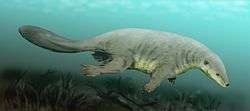Docodonta
| Docodonts Temporal range: Middle Jurassic–Early Cretaceous | |
|---|---|
 | |
| Life restoration of a Castorocauda | |
| Scientific classification | |
| Kingdom: | Animalia |
| Phylum: | Chordata |
| Class: | Mammalia |
| Order: | †Docodonta Kretzoi, 1946 |
| Subgroups | |
| |
Docodonta is an order of extinct mammaliaforms that lived during the mid- to late-Mesozoic era. Their most distinguishing physical features were their relatively sophisticated set of molars, from which the order gets its name. In the fossil record, Docodonta is represented primarily by isolated teeth and bits of jawbones. While most of these specimens have been found across former Laurasia (modern-day North America, Europe, and Asia), some have also been found from Gondwana (modern-day India and Southern Hemisphere).
Docodonts are not quite as closely related to the placentals and marsupials as the monotremes are, so they are not included among the crown-group mammals. Because of the complexity of their molars and the fact that they possess the dentary-squamosal jaw joint, though, they have generally been regarded as mammals. Some authors do limit the term "Mammalia" to the crown group, however, excluding mammaliaforms like the docodonts.
Docodonts are traditionally thought to have been primarily herbivorous or insectivorous, but Castorocauda and Haldanodon were specialised for an aquatic lifestyle, and indeed docodonts as a whole might have had tendencies towards aquatic habits given their prevalence in wetland environments.[1]
Taxonomy[2][3]
- Order †Docodonta Kretzoi 1958 sensu Kielan-Jaworowska, Cifelli & Luo 2004
- Family †Docodontidae (Marsh 1887) Simpson 1929
- †Agilodocodon scansorius Meng et al. 2015
- †Docofossor brachydactylus Luo et al. 2015
- †Gondtherium dattai Prasad & Manhas 2007
- †Cyrtlatherium canei Freeman 1979 sensu Sigogneau-Russell 2001 [Simpsonodon oxfordensis Kermack et al. 1987]
- †Haldanodon exspectatus Kühne & Krusat 1972 sensu Sigoneau-Russell 2003
- †Borealestes Waldman & Savage 1972
- †B. serendipitus Waldman & Savage 1972
- †B. mussetti Sigogneau-Russell 2003
- †Dsugarodon zuoi Pfretzschner et al. 2005 [Acuodulodon Hu, Meng & Clark 2007; Acuodulodon sunae Hu, Meng & Clark 2007]
- †Castorocauda lutrasimilis Ji et al. 2006
- †Simpsonodon Kermack et al. 1987
- †S. splendens (Kühne 1969) [Cyrtlatherium spendens (Kühne 1968) emend Averianov et al. 2010]
- †S. sibiricus Averianov et al. 2010 [Cyrtlatherium sibiricus (Averianov et al. 2010)]
- †Krusatodon kirtlingtonensis Sigogneau-Russell 2003
- †Itatodon tatarinovi Lopatin & Averianov 2005
- †Hutegotherium yaomingi Averianov et al. 2010
- †Paritatodon kermacki (Sigoneau-Russell 1998) Martin & Averianov 2010 [Shuotherium kermacki Sigoneau-Russell 1998]
- †Tashkumyrodon desideratus Martin & Averianov 2004
- †Tegotherium gubini Tatarinov 1994
- †Sibirotherium rossicus Maschenko, Lopatin & Voronkevich 2002
- †Reigitherium bunodontum Bonaparte 1990
- †Peraiocynodon Simpson 1928
- †P. inexpectatus Simpson 1928
- †P. major Sigogneau-Russell 2003
- †Docodon Marsh 1881 [Dicrocynodon Marsh 1880; Diplocynodon Marsh 1880 non Pomel 1847; Ennacodon Marsh 1890; Enneodon Marsh 1887 non Prangner 1845; Dryolestes Marsh 1879]
- †D. apoxys Rougier et al. 2014
- †D. apoxys (Marsh 1880) Marsh 1881 [Dicrocynodon victor Marsh 1880; Diplocynodon victor Marsh 1880]
- †D. striatus (Marsh 1880) Marsh 1881 [Dicrocynodon striatus Marsh 1880]
- †D. affinis (Marsh 1887) [Enneodon affinis Marsh 1887]
- †D. crassus (Marsh 1887) [Enneodon crassus Marsh 1887; Ennacodon crassus (Marsh 1887)]
- †D. superus Simpson 1929 [Dicrocynodon victor Marsh 1880]
- Family †Docodontidae (Marsh 1887) Simpson 1929
See also
References
- ↑ Paleontology and Geology of the Upper Jurassic Morrison Formation: Bulletin 36
- ↑ Mikko's Phylogeny Archive Haaramo, Mikko (2007). "Docodonta - docodonts". Retrieved 30 December 2015.
- ↑ Paleofile.com (net, info) . "Taxonomic lists- Mammals". Retrieved 30 December 2015.
- G. V. R. Prasad and B. K. Manhas. "First docodont mammals of Laurasian affinity from India". Current Science. November 10, 2001.